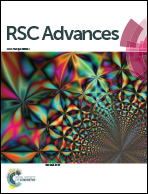Superparamagnetic [sic] nanofibers by electrospinning†
Abstract
The preparation of superparamagnetic thin fibers by electrospinning dispersions of nanosized magnetite (Fe3O4, SPIO/USPIO) in a PMMA/PEO polymer solution is reported. The saturation magnetization and coercivity were not affected by the concentration (0, 1, 10, 20 wt%) or fiber orientation, showing hysteresis loops with high magnetization (64 A m2 kg−1 @ 500 kA m−1) and record low coercivity (20 A m−1). AC susceptibility measurements vs. temperature at frequencies from 60 to 2 kHz confirmed superparamagnetism. The mechanical properties were only slightly dependent on the particle concentration because the nanoparticles were separately encapsulated by the polymer. A uniform fibre fracture cross section was found at all the investigated particle contents, which suggests a strong interaction at the polymer/particle interface. A theoretical value of the magnetic low field susceptibility was calculated from the Langevin function and compared with measured values. The results show a distinct but concentration-independent anisotropy, favoring magnetization along the fiber orientation with no sign of exchange interaction, explained by complete nanoparticle separation. Superparamagnetism cannot be inferred from particle size alone, so a relevant interpretation and criterion for superparamagnetism is presented, in accordance with Neel's original definition. From the measurements, it can be concluded that magnetic characterization can be used to elucidate the material morphology beyond the resolution of available microscopy techniques (TEM and SEM).
![Graphical abstract: Superparamagnetic [sic] nanofibers by electrospinning](/en/Image/Get?imageInfo.ImageType=GA&imageInfo.ImageIdentifier.ManuscriptID=C5RA27791D&imageInfo.ImageIdentifier.Year=2016)


 Please wait while we load your content...
Please wait while we load your content...